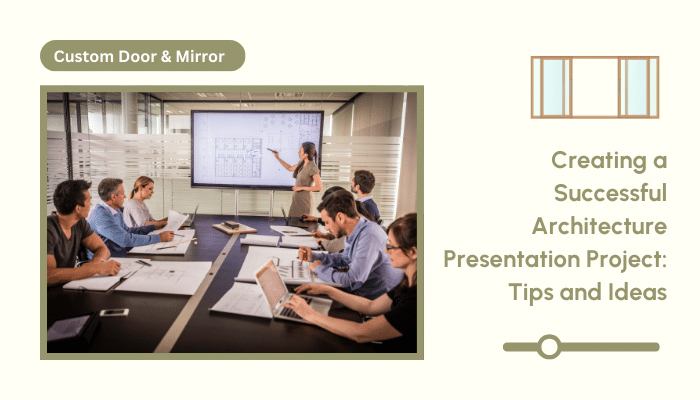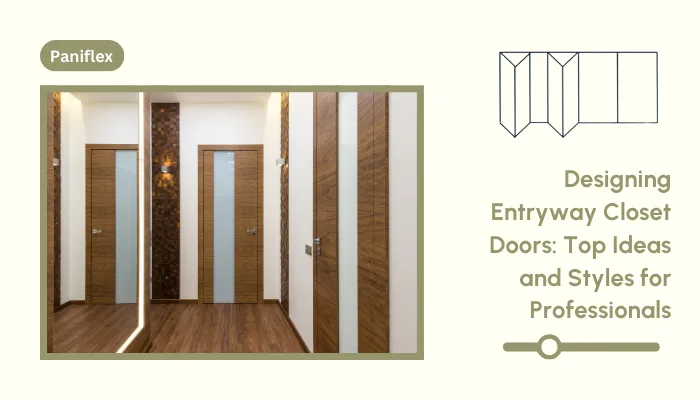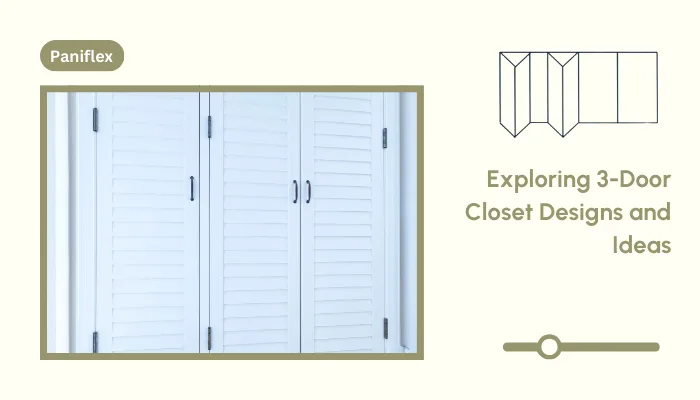Have you ever struggled to engage your audience during an architecture presentation? It can be challenging to turn complex designs into compelling narratives that resonate with clients and stakeholders.
In such a scenario, the solution is to consider how you deliver your information. Studies have shown that storytelling presentations are more effective and 22 times more likely to be remembered by the audience.
Using interactive elements in a presentation, for instance, increases the participation level to up to 92%.
These statistics demonstrate the power of thoughtful design and narrative in making architectural presentations impactful.
Ready to experience the benefits of custom closet doors? Explore our range of Paniflex products now.
Focus on storytelling, strategic visuals, and a deep understanding of your audience, and you will transform your presentations into impactful experiences that convey your vision and inspire and persuade the audience.
A good architecture presentation should showcase your creative work and clearly and impactively communicate your vision.
Finding the right balance between aesthetic expression and clear messaging can always be overwhelming, but knowing the basics can make it manageable.
Let’s look at the top strategies for delivering memorable presentations and connecting with your audience quickly.
Introduction to Architecture Presentation Projects
An architecture presentation is not just about showing drawings or renderings. It is a critical communication tool that bridges the gap between design concepts and audience understanding. Here’s why it holds such importance:
- Effective communication is key: Your designs may be brilliant, but they need to be understood by clients, stakeholders, or peers. A well-crafted presentation ensures your ideas shine through, helping you gain approvals, attract investors, or inspire collaborators.
- Presentations convey ideas. They allow you to discuss your design philosophy, functional solutions, and artistic choices in a way that resonates with your audience. For example, describing how your design addresses form and function can give them confidence in your vision.
- Challenges in storytelling: Building a coherent and engaging narrative is always tricky. You have to connect things like floor plans, material selections, and environmental considerations into a seamless story that holds people’s attention. That requires strategic planning and an understanding of how to structure information properly.
- Creating emotional bonds: An excellent presentation is more than a means of transmitting information. It makes the audience feel something. Point out how your design improves users’ lives or improves public areas.
Understanding these aspects of architectural presentations allows you to enter every project with an opportunity to make emotional bonds and present the full power of your designs.
How do you make every project stand out? Understanding key aspects of architectural presentations can help you connect emotionally and showcase your designs.
Be an architect, contractor, or designer, and Paniflex is your partner to success, offering custom doors and mirrors that streamline your workflow and deliver exceptional results.
Now that we have a basic understanding of architecture presentation projects, we can learn how to work around the content strategy and know the audience.
Understanding the Audience and Content Strategy
Start by knowing who you are presenting to and what they value. Knowing your audience’s background, priorities, and expectations will enable you to craft a presentation that speaks directly to their interests.
Aligning your message with their needs will ensure that your presentation resonates and does its intended job. Here’s what you can do:
- Consider their background: Tailor your presentation to suit the audience. Technical experts focus on structural details, while clients prioritize cost and aesthetics.
- Highlight key takeaways: Emphasize memorable points such as sustainability, innovative use of space, or cultural relevance. Make your message clear and impactful.
- Balance details and clarity: Provide necessary information with visuals such as charts or diagrams to simplify complex ideas and avoid overwhelming your audience.
- Prepare for questions: Address possible concerns, such as costs or compliance, to demonstrate thorough planning and build trust.
- Connect emotionally: Use stories or examples to show how your design solves problems or improves lives, making it relatable and memorable.
Now that you know the tricks to understand your audience, let us learn how to design an architectural presentation.
Designing the Architectural Presentation
The design of your presentation is as important as its content. A visually appealing layout makes your ideas easier to understand and remember while also enhancing professionalism and credibility in the eyes of your audience.
Here are some ways to design a presentation:
- Choose the right size and orientation: Consider whether your boards will be viewed up close, from afar, or digitally. Then, determine your size and orientation accordingly.
For instance, panorama visuals look great in landscape orientation, while detailed floor plans work fine in portrait orientation.
- Plan a practical layout: Guide the viewer’s eye through your presentation in a logical sequence. Use clear focal points to draw attention to key elements like concept sketches, material samples, or final renderings.
- Use a grid system: A structured grid keeps your drawings and text aligned, giving your design a professional look. Modular grids with constant spacing and columns are great for maintaining uniformity, whereas column-based layouts allow for different content types.
Divide your board into sections that focus on different aspects of your design: site analysis, conceptual development, technical details, and so on.
- Strategically place content: Arrange elements so viewers can easily follow your narrative. Place the most critical visuals, such as key renders or plans, at eye level to capture immediate attention.
Group related content logically-for example, all site analysis data in one section-to make navigation intuitive. Leave enough space to avoid visual clutter, and use arrows or numbering to guide the viewer effectively through the flow of information.
Need a reliable partner to meet tight deadlines without sacrificing quality? Paniflex is your trusted ally. Their precision-engineered doors are easy to install, saving you time on site and ensuring smooth project completion.
Their products help you stay efficient and deliver excellence from start to finish, just like organizing data for intuitive navigation.
So, how can you create impactful visual styles for your presentations? Let us find out how.
Image source: pexels.com
Visual Techniques for Impact
The visual style of your presentation will influence how your audience perceives your work. Strong visuals enhance understanding and create an emotional connection, making your designs more relatable and memorable.
They can also help simplify complex ideas, highlight key features, and draw attention to your most innovative concepts, leaving a lasting impression on your audience. Here are some techniques to create visual impacts in your presentation:
- Make a visual hierarchy: Use size, color, or placement to emphasize key elements.
For example, bigger images or bold headings can draw attention to essential features such as the main facade or innovative features. In addition, layering visuals or using varying line weights in sketches can help draw attention and create depth in your presentation.
- Use colors wisely: Select colors that complement your design without overpowering it. Neutral backgrounds often work best to let your work stand out. For added impact, use warm tones to evoke energy or cool tones to convey calmness. Accent colors can draw attention to focal points or significant features.
- Choose impactful images: High-quality images support your narrative. Place them in a logical order to guide the audience. Include a mix of renders, sketches, and photographs to provide a well-rounded view of your project. Consider editing images for consistency in lighting and tone to maintain a cohesive visual style.
- Use readable fonts: Avoid ornate fonts. Use straightforward, professional typography to make it legible. Fonts such as Helvetica, Arial, or Futura are commonly used for their clean, professional look. Limit the number of font styles to two or three to avoid visual clutter and maintain consistency.
Now that you know how to create an appealing visual presentation for architecture, let’s learn about narrative and storytelling.
Narrative and Storytelling
An excellent architecture presentation tells a story that makes people care and believe. It’s not just presenting designs, but it is weaving a narrative that draws out the purpose, creativity, and impact of the work.
The better the storytelling, the better the presentation can be: more relatable, memorable, and impactful. Use these techniques to create a compelling narrative:
- Create a narrative: Organize your spread to illustrate the progression of your project from idea to finished product.
For instance, start with site analysis, then proceed to design inspiration, and finally, end with final renderings. Use annotations or captions to describe the reasoning behind each stage and mark significant decision-making points.
- Engage through storytelling methods: Explain the “why” behind your decisions. Describe how certain design elements can help solve problems or answer client needs, which could be aligned with environmental goals. Use case studies or user scenarios to help illustrate your point to the audience.
- Sequence logically: Organize images and text in such a way that your audience will immediately understand the progression of your project. Use elements such as arrows, numbered sections, or fade effects to create smooth transitions between topics, keeping them engaged.
- Incorporate user perspectives: Integrate testimonials, user feedback, or created personas to showcase how your design aligns with the needs and expectations of its end-users. This provides credibility and adds a personal dimension to your story.
- Use a thematic approach: Connect your story with a consistent theme, such as environmental sustainability, innovative technology, or cultural heritage. Reinforce this theme with recurring imagery, consistent color schemes, or repeated motifs to create a cohesive message.
- Enhance with multimedia: Where possible, add multimedia elements like videos, animations, or interactive 3D renderings to bring your story to life. These elements enable your audience to visualize complex concepts and even feel more immersed in your presentation.
Understanding how to design a precise presentation for your architectural project is essential. Here are some practical tips.
Practical Tips for Presentation
Here are actionable tips for refining your presentation and making it engaging and effective. These strategies enhance the clarity of your message, ensuring that your audience remains captivated from start to finish.
Ready to experience the benefits of custom closet doors? Explore our range of Paniflex products now.
Whether you are presenting technical expertise to experts, explaining things to clients, or justifying your vision to stakeholders, these tips help you communicate your vision with impact and professionalism. Here’s what you can do:
- Keep the text concise: Use short sentences and bullet points to convey your message quickly. Replace lengthy paragraphs with visually engaging infographics. Use plain language to avoid jargon and ensure clarity for all audience members.
- Let sketches speak: Instead of lengthy descriptions, use diagrams or sketches to represent your points. Exploded axonometric diagrams or sectional drawings can effectively represent spatial relationships and material usage.
- Don’t cram: Leave enough white space to make your content clear and easy to read. Use margins and spacing thoughtfully to lead your viewer’s eye through this presentation in a logical progression. A clean, minimalistic presentation is always easier to read and looks really professional, with the correct elements standing out.
- Practice thoroughly: Practice your delivery to achieve smooth timing and confident speech. Record yourself to mark down areas for improvement, then focus on pacing, tone, and connecting with the audience by making eye contact and encouraging them with questions.
How can you ensure smooth project execution under tight deadlines? Just like you rehearse your delivery for smooth time and confident results, Paniflex ensures precision and ease: custom doors designed for quicker installation, saving time in meeting project needs.
Now, let us understand the technical aspects and innovations involved in making a good presentation.
Technical Aspects and Innovation
Leverage technology to take your presentation to the next level by combining advanced techniques with innovative tools. In today’s fast-paced design environment, the effective use of technology can set your work apart, making your ideas not only more visually compelling but also more straightforward for audiences to engage with and understand. By integrating cutting-edge tools and methods, you can showcase the true potential of your designs while leaving a lasting impression on your viewers. Here’s how you can do it:
- Enhance your drawings: With advanced rendering techniques, bring life to your designs by using realistic lighting, textures, and shadows in visuals that immerse the audience in the project. Use atmospheric effects such as fog or sunlight to give the design a sense of time and place.
- Explore digital tools: Platforms such as Photoshop, Illustrator, and InDesign can create polished professional presentation boards. Use software like SketchUp or Rhino for accurate 3D modeling and visualization. Combine this with rendering software such as V-Ray or Lumion to produce high-quality visuals that convey depth and reality.
- Add 3D visualizations: Take your presentation to the next level with 3D walkthroughs or animations. These dynamic elements allow your audience to experience the space from a first-person perspective, offering a realistic view of scale and functionality. Interactive models that can be explored on tablets or VR headsets can also provide a cutting-edge experience.
- Use augmented reality (AR) and virtual reality (VR): AR and VR technologies can transform how your designs are experienced. Allow your audience to step into your project virtually and interact with elements in real-time. These tools make your presentation more engaging and provide a deeper understanding of your vision.
- Integrate parametric design tools: For complex geometries and innovative structures, consider using parametric design tools like Grasshopper or Dynamo. These tools enable precise control and adaptability, showcasing your ability to innovate and solve design challenges effectively.
Now that we know everything about creating a compelling architectural presentation, here are some of the common mistakes and solutions to avoid them.
Common Mistakes and How to Avoid Them
Even the best presentations can go wrong because of avoidable mistakes. While common, these mistakes can pull down the overall impact of your work. Identifying and correcting these issues not only strengthens your presentation but also boosts your confidence and professionalism.
Whether it is fine-tuning your visuals or fine-tuning your delivery, minor improvements can lead to significant gains in effectiveness. Here’s how to avoid making mistakes:
- Using too much text: Do not burden the audience with long paragraphs of words. Use more images and fewer words in bullet points to get your message across. Annotated diagrams clarify complicated ideas without using much text.
- Practicing insufficiently: Without adequate rehearsal, the presentation will be disjointed and not very convincing. Rehearse several times to make your timing and delivery crisp. Mimic accurate presentation scenarios to perform confidently and overcome possible mishaps.
- Misusing scales: Inaccurate or inconsistent scaling can confuse your audience. Ensure all drawings and renderings are appropriately scaled and include a scale bar for reference. Cross-check dimensions and annotations for accuracy.
- Ignoring narrative flow: Disorganized content disrupts comprehension. Use clear headings, numbered sections, and transitions to create a logical sequence. Ensure each part of your presentation builds on the previous one, seamlessly guiding the audience through your story.
- Avoid passive experience: Failure to interact with the audience leads to a passive experience. Incorporate question time, make interactive elements, or have some time for feedback so that the audience is involved and interested.
Now that everything is sorted and you know how to design a good architectural presentation, let us know what happens after the presentation is made.
After the Presentation
Your work does not end when the presentation is over. Instead, this is where the real growth begins. Use the post-presentation period to reflect on your performance, gather insights, and identify areas for improvement.
This process not only helps refine your skills for future success but also ensures you are continuously evolving as a professional, adapting to new challenges and expectations in every presentation. Here’s what happens after the presentation is made:
- Gather feedback: Ask for constructive criticism to identify areas for improvement. Consider conducting a brief Q&A session to address audience questions and gain insights into their perspectives. Encourage candid feedback to understand better how your presentation was received.
- Self-assessment: Record your presentation so that you can go over your strengths and weaknesses. Pay attention to how you handled transitions, how you explained concepts, and how you interacted with the audience. Reflect on what worked and what you could change for future presentations.
- Refine your approach: Apply what you learn to future projects to continue improving. Record successful techniques, tools, and strategies that worked well for your audience. Based on these experiences, create a checklist or framework to streamline your preparation for the next presentation.
- Follow up with your audience: Reach out to attendees with additional materials, such as detailed design documents or summaries of key points. This gesture reinforces your message and demonstrates your commitment to communication and collaboration.
Conclusion
Delivering a compelling architecture presentation is not just about showcasing your designs; it’s about effectively communicating your vision and leaving a lasting impression. By mastering storytelling, using innovative tools, and focusing on clarity, you can turn your presentations into powerful assets that build confidence and collaboration.
At Paniflex, we recognize the challenges architects face when creating impactful presentations. That’s why we offer solutions to simplify your workflow and enhance your ability to create visually stunning and persuasive presentations. Our tools empower you to focus on designing exceptional spaces while ensuring your ideas connect with your audience.
Schedule a free call today to see how Paniflex can help transform your presentations into unforgettable experiences.






